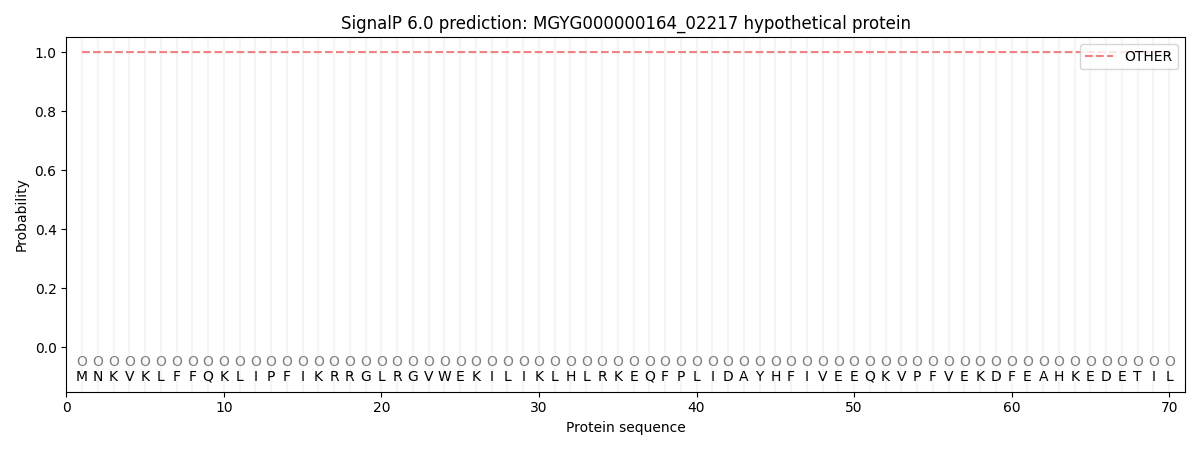You are browsing environment: HUMAN GUT
CAZyme Information: MGYG000000164_02217
You are here: Home > Sequence: MGYG000000164_02217
Basic Information |
Genomic context |
Full Sequence |
Enzyme annotations |
CAZy signature domains |
CDD domains |
CAZyme hits |
PDB hits |
Swiss-Prot hits |
SignalP and Lipop annotations |
TMHMM annotations
Basic Information help
| Species | Mediterraneibacter_A butyricigenes | |||||||||||
|---|---|---|---|---|---|---|---|---|---|---|---|---|
| Lineage | Bacteria; Firmicutes_A; Clostridia; Lachnospirales; Lachnospiraceae; Mediterraneibacter_A; Mediterraneibacter_A butyricigenes | |||||||||||
| CAZyme ID | MGYG000000164_02217 | |||||||||||
| CAZy Family | GT4 | |||||||||||
| CAZyme Description | hypothetical protein | |||||||||||
| CAZyme Property |
|
|||||||||||
| Genome Property |
|
|||||||||||
| Gene Location | Start: 252918; End: 254159 Strand: + | |||||||||||
CDD Domains download full data without filtering help
| Cdd ID | Domain | E-Value | qStart | qEnd | sStart | sEnd | Domain Description |
|---|---|---|---|---|---|---|---|
| cd03801 | GT4_PimA-like | 1.12e-13 | 200 | 401 | 145 | 365 | phosphatidyl-myo-inositol mannosyltransferase. This family is most closely related to the GT4 family of glycosyltransferases and named after PimA in Propionibacterium freudenreichii, which is involved in the biosynthesis of phosphatidyl-myo-inositol mannosides (PIM) which are early precursors in the biosynthesis of lipomannans (LM) and lipoarabinomannans (LAM), and catalyzes the addition of a mannosyl residue from GDP-D-mannose (GDP-Man) to the position 2 of the carrier lipid phosphatidyl-myo-inositol (PI) to generate a phosphatidyl-myo-inositol bearing an alpha-1,2-linked mannose residue (PIM1). Glycosyltransferases catalyze the transfer of sugar moieties from activated donor molecules to specific acceptor molecules, forming glycosidic bonds. The acceptor molecule can be a lipid, a protein, a heterocyclic compound, or another carbohydrate residue. This group of glycosyltransferases is most closely related to the previously defined glycosyltransferase family 1 (GT1). The members of this family may transfer UDP, ADP, GDP, or CMP linked sugars. The diverse enzymatic activities among members of this family reflect a wide range of biological functions. The protein structure available for this family has the GTB topology, one of the two protein topologies observed for nucleotide-sugar-dependent glycosyltransferases. GTB proteins have distinct N- and C- terminal domains each containing a typical Rossmann fold. The two domains have high structural homology despite minimal sequence homology. The large cleft that separates the two domains includes the catalytic center and permits a high degree of flexibility. The members of this family are found mainly in certain bacteria and archaea. |
| cd03809 | GT4_MtfB-like | 3.23e-09 | 234 | 397 | 186 | 360 | glycosyltransferases MtfB, WbpX, and similar proteins. This family is most closely related to the GT4 family of glycosyltransferases. MtfB (mannosyltransferase B) in E. coli has been shown to direct the growth of the O9-specific polysaccharide chain. It transfers two mannoses into the position 3 of the previously synthesized polysaccharide. |
| cd03800 | GT4_sucrose_synthase | 6.18e-09 | 225 | 396 | 196 | 395 | sucrose-phosphate synthase and similar proteins. This family is most closely related to the GT4 family of glycosyltransferases. The sucrose-phosphate synthases in this family may be unique to plants and photosynthetic bacteria. This enzyme catalyzes the synthesis of sucrose 6-phosphate from fructose 6-phosphate and uridine 5'-diphosphate-glucose, a key regulatory step of sucrose metabolism. The activity of this enzyme is regulated by phosphorylation and moderated by the concentration of various metabolites and light. |
| cd03825 | GT4_WcaC-like | 9.30e-09 | 200 | 385 | 142 | 344 | putative colanic acid biosynthesis glycosyl transferase WcaC and similar proteins. This family is most closely related to the GT4 family of glycosyltransferases. Escherichia coli WcaC has been predicted to function in colanic acid biosynthesis. WcfI in Bacteroides fragilis has been shown to be involved in the capsular polysaccharide biosynthesis. |
| cd03794 | GT4_WbuB-like | 2.24e-04 | 223 | 398 | 200 | 391 | Escherichia coli WbuB and similar proteins. This family is most closely related to the GT1 family of glycosyltransferases. WbuB in E. coli is involved in the biosynthesis of the O26 O-antigen. It has been proposed to function as an N-acetyl-L-fucosamine (L-FucNAc) transferase. |
CAZyme Hits help
| Hit ID | E-Value | Query Start | Query End | Hit Start | Hit End |
|---|---|---|---|---|---|
| QYX25932.1 | 2.24e-190 | 1 | 411 | 1 | 407 |
| AMK55186.1 | 7.17e-172 | 4 | 408 | 1 | 400 |
| CCI71311.1 | 3.91e-103 | 18 | 403 | 23 | 406 |
| ABM68323.1 | 5.76e-98 | 12 | 409 | 24 | 414 |
| BBP72133.1 | 9.00e-98 | 2 | 402 | 8 | 402 |
Swiss-Prot Hits download full data without filtering help
| Hit ID | E-Value | Query Start | Query End | Hit Start | Hit End | Description |
|---|---|---|---|---|---|---|
| Q50864 | 2.37e-25 | 149 | 402 | 995 | 1254 | O-antigen biosynthesis protein RfbC OS=Myxococcus xanthus OX=34 GN=rfbC PE=4 SV=1 |
SignalP and Lipop Annotations help
This protein is predicted as OTHER

| Other | SP_Sec_SPI | LIPO_Sec_SPII | TAT_Tat_SPI | TATLIP_Sec_SPII | PILIN_Sec_SPIII |
|---|---|---|---|---|---|
| 1.000038 | 0.000000 | 0.000000 | 0.000000 | 0.000000 | 0.000000 |
